Ike X Boyd Fire Emblem Path of Radiance Art
Fire Emblem: Path of Radiance is a tactical role-playing game developed by Intelligent Systems and published by Nintendo for the Nintendo GameCube video game panel. The game was released on April 20, 2005 in Japan, Oct 17, 2005 in Northward America, November xv, 2005 in Europe and Dec 1, 2005 in Australia. Information technology is the 9th Fire Emblem title, and the 3rd Burn Emblem title to be released in North America.
Path of Radiance was the first Fire Emblem title to feature characters having voices and the first to characteristic 3D graphics for its character models, maps, and battle screens. It is also the first Burn down Emblem game to be released for a home console in N America, Australia, and Europe. Its gameplay introduced a new organisation for boxing preparation and a new prepare of races, collectively known as laguz.
A sequel to Path of Radiance, Burn down Emblem: Radiant Dawn, was released in Japan for the Wii on February 22, 2007 and in Due north America on November 5, 2007.
Contents
- 1 Setting
- 2 Plot
- 3 Characters
- 4 Chapters
- 5 The Fire Emblem
- 6 Gameplay mechanics
- 6.one Modes
- 6.2 New Race
- six.3 Unit classes
- 6.4 Battle Preparation
- 6.5 Biorhythm
- vi.six Skill System
- 6.7 Experience
- 6.eight Weapons
- 6.9 Back up System
- 6.10 Changes from Japanese version
- 7 Game Boy Advance Link Connection
- 8 Graphics engine and musical score
- nine Reception
- 10 Trivia
- 11 Gallery
Setting
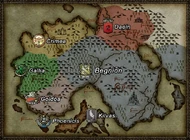
A map of Tellius. The highlighted nations are Gallia (green), Crimea (gilded), and Daein (crimson) Begnion (bluish) Goldoa (purple) phoenicis (orange) Kilvas (grey).
Path of Radiance is set on the fictional continent of Tellius. The continent is divided into seven nations that are either governed past beorc, the game'due south terminology for humans, or laguz, a race of shape-shifters capable of taking on the forms of animals.
- Crimea - A beorc kingdom that is abode to the Greil Mercenaries. At the start of the game, it is invaded by Daein. It was ruled by King Ramon until his death at the hands of King Ashnard. He is succeeded by his daughter, Elincia.
- Daein - A beorc kingdom that had get antagonistic ever since Male monarch Ashnard ascended the throne.
- Begnion - A beorc theocracy worshiping the goddess Ashera. Its figurehead is Apostle Sanaki.
- Gallia - Home to the beast laguz, information technology recently improved relations with Crimea. Its ruler is King Caineghis.
- Phoenicis - Home to the hawk laguz, its ruler is King Tibarn.
- Kilvas - Home to the raven laguz, who are considered more cunning and dishonorable than the Hawks. Foreigners are not welcome unless they pay well. Its ruler is King Naesala.
- Goldoa - Home of the dragon laguz, information technology isolates itself from the rest of Tellius. Its ruler is Dheginsea.
- Serenes Woods - A forest located in northwestern Begnion, home to the heron laguz. However, it was burnt down 20 years earlier the events of the game and the herons were wiped out, save for its king Lorazieh, Prince Reyson and Rafiel, Princess Leanne and Lillia.
Plot
The protagonist, Ike, the son of Greil, begins the game as the newest fellow member of his father's mercenary visitor, the Greil Mercenaries. The company operates inside the borders of Crimea, a nation of humans (referred to as "beorc") that shares its southern border with Gallia, a nation of Beast laguz, or humanoids capable of transforming into animals. Every bit a fellow member of the Greil Mercenaries, Ike embarks on missions to aid locals seeking assist to drive away bandits.
The lives of Ike and his fellow mercenaries change when the neighboring beorc nation, Daein, invades Crimea. After the Crimean capital falls to the invasion, Ike comes across an unconscious woman in a forest that turns out to exist the Crimean princess, Elincia Ridell Crimea, whose political party had fallen while escorting her escape to the allied nation of Gallia. Faced with the ruthless Daein assail, Greil leads the mercenaries out of Crimea and towards Gallia, only is mortally wounded past a Daein general known only as the Black Knight. These events marker the beginning of a long journey that volition accept Ike, Elincia, and the mercenaries across the continent and back in an effort to defeat Daein and restore Crimea's royalty to the throne.
Over the course of the game, Ike and his companions must overcome long-held racial tensions between the beorc and laguz in club to form an brotherhood against their true enemy, Ashnard, King of Daein. In particular, Ike manages to reestablish relations between the beorc nation of Begnion and the few remaining members of the heron laguz association, which was annihilated in an human activity of genocide known as the Serenes Massacre. With this accomplishment, Ike is given command of a patchwork army that he leads into Daein and finally back to Crimea, where he confronts the Black Knight and ultimately King Ashnard himself.
Characters
See chief article: List of characters in Burn Emblem: Path of Radiance
Chapters
See main article: Chapters (Fire Keepsake: Path of Radiance)
The Burn Keepsake
In Path of Radiance, the Fire Emblem takes the course of a simple bronze medallion also known as Lehran's Medallion. Information technology holds the soul of an evil god, and tin disrupt the level of chaotic energy in nigh whatever that accept direct hold of it, driving its claimant violently berserk. For example, when Greil took hold of the medallion, it caused him to become berserk and kill anybody in sight, including his married woman, Elena. It was only when she took the medallion from his hand in her final moments that Greil regained his sanity. Just a person with a high level of spiritual residual is capable of holding the medallion without losing his or her listen. Ike's female parent, Elena, and his younger sister, Mist, are two such people.
The medallion once belonged to the Heron clans that dwelt in the Serenes Forest inside Begnion. They were charged with protecting the medallion and so that the evil god would not be released. However, the Serenes Massacre forced Lillia, a fellow member of the Heron royal family, to flee with the medallion, merely to exist captured past Ashnard's forces. Lillia was ordered to complimentary the dark god, but she could not. She befriended Elena and gave the medallion to her. Mist eventually inherited it from her female parent.
In the terminal chapter of the "Difficult" difficulty (and "Bedlamite" in the Japanese version), Ashnard uses the medallion afterwards his initial defeat to gain godlike power. Despite this strength growth, he is still defeated past Ike and the party.
Gameplay mechanics
The game retains the fundamental gameplay mechanics of the Burn down Emblem series, such equally the weapon triangle and filigree-based battlefields. However, there are some changes to the gameplay, such as the style in which the group prepares and units support each other, also equally a change to the magic arrangement.
Modes
At the start, the original Japanese version of the game provides "Normal" and "Hard" modes, with the tertiary way, "Maniac", beingness unlocked after completing the Normal mode. In English language-language releases, the three modes were renamed to "Easy", "Normal", and "Hard". The easiest of the modes assumes the player has never played a Fire Emblem game before and includes in-depth in-game tutorials, whereas the other modes only include them as a reference. In the hardest style, enemies are stronger and more numerous, and sure features, like saving during battles, accept been disabled. In add-on, both EXP gain and bonus EXP accept been toned down significantly.
New Race
Path of Radiance introduces the laguz changelings—humanoid creatures that transform into powerful animals when their transformation gauge is full. The bar inside the transformation gauge increases each turn; the laguz spend roughly an equal amount of fourth dimension in each course, though the humanoid form tin can be completely bypassed if the laguz is equipped with either a Demi Band or a Laguz Ring—the sometime of which decreases the user's boxing statistics. When in animal form, laguz apply the natural weapons of their species—claws for beasts, beaks for birds, and jiff attacks for dragons. The natural weapons of a laguz will never suspension with use, dissimilar normal beorc weaponry, just laguz do non use beorc weapons and are thus unable to attack when not in animal form. There are three species of laguz—beasts, birds, and dragons. These species are further divided into iii classes each, although not all of them are playable. Beast laguz are divided into Cats, Tigers, and lions; birds into ravens, hawks, and Herons; and dragons are divided into red, white, and black dragons. Each laguz species has an elemental weakness: fire for beasts, wind for birds, and thunder for dragons. Birds can fly in either form, just also take the weakness to bows associated with flying units.
Unit classes
In Path of Radiance, nigh units that tin can promote to a college-tier course will do so automatically upon reaching level twenty-one. Players can as well use the Master Seal particular to immediately promote any unit currently between levels ten and 20. Ike and Volke are exceptions, in that their promotions are based on story events, with Ike'south promotion occurring automatically. Laguz characters cannot promote, but instead have a level cap of thirty for their classes.
Path of Radiance introduces some new classes while omitting some that were present in earlier Fire Keepsake installments. There have also been changes to which weapons some classes can wield. Ex: Paladins have the option of using bows, where in previous games they could not.
Battle Preparation
Path of Radiance is the first Fire Keepsake game to feature a "Base of operations screen" forth with the "Battle Preparations" screen. Before the Base screen appears, Soren provides information on the previous battle, including the weapons and the distribution of Bonus Feel and skills. Furthermore, players tin engage in Support conversations and the new "Info" conversations, chapter-specific conversations rated on a scale of 1 to iii stars. I star denotes conversations that provide story background, two stars mark conversations that provide hints on how to proceed in the coming battle, and three stars indicate that the conversation may yield a special power, item, or new playable graphic symbol.
Biorhythm
A boxing mechanic introduced in Path of Radiance, Biorhythm is a universal modifier that affects all centrolineal and enemy units on the battlefield. A character's electric current biorhythm state is charted with a sine wave graph visible in a unit'due south status screen. The biorhythm advances on a turn by turn ground, ascension and falling every bit the battle proceeds. When a character's biorhythm is high, they gain a bonus to their Striking and Avoid chances, but incur a penalty when their biorhythm is depression.
Skill System
The skill system, which was introduced in Burn Emblem: Genealogy of the Holy War, has dissimilar mechanics in this game. Each character has a capacity gauge that allows for mastery of skills. By using a skill scroll, the character learns the respective skill and a certain amount of slots are taken up in the chapters estimate, usually determined by how useful the skill is. The space of the capacity estimate varies between classes and characters. Barring a few exceptions, any unit of measurement can learn any skill. Most skills requite the unit an reward in battle; Ike'south Aether, for example, allows Ike to deal damage equally if his opponent has half their existent defense force, while healing him for half the harm he would deal. Skills tin exist unassigned from characters to provide room for new skills, but doing then causes the unassigned skill to vanish.
Experience
Path of Radiance introduced a new feature called Bonus Feel. At the end of every chapter, Bonus Experience is awarded based on certain factors such as number of enemies remaining and turns taken to complete the affiliate. It tin can be freely distributed to units between battles through the Base card. Just as in the previous Fire Emblem installments, ane hundred Experience Points are required to level upwardly.
Some other unique characteristic to Path of Radiance is Fixed mode, which is an alternative method for unit of measurement growth that is available after completing the game one time. Random mode—the method used in all other titles in the serial, as well every bit in the first playthrough of Path of Radiance—gives units a gear up percentage chance to increase a given stat upon level up. This chance is termed a "growth rate." Due to the "hazard nature" of this system, a unit that levels up may proceeds many stat increases or none at all. In Fixed mode, units instead earn experience towards a stat increment as they earn standard experience. This "stat feel" is kept per stat, and if enough has been accumulated, that stat will increase the next time the unit gains a level and "stat experience" will render to zero; otherwise, it will carry over to the next level. Units earn stat experience based on their individual growth rates, which can be modified by the items a unit has equipped and the grade of the enemy that information technology is attacking.
Weapons
For a listing of weapons in the game run across: List of weapons in Fire Emblem: Path of Radiance
The weapon forging system, introduced in this game, allows players to create improved versions of some of the weapons available in shops. Players can forge 1 weapon during every visit to the Base of operations screen. To forge a weapon, the player first chooses a base weapon to modify. Choices of base of operations weapon are initially limited, but more options become available as the role player progresses through the game. The histrion tin can then increase or decrease several statistics of the weapon, such every bit force and weight. The further away from the statistics of the base of operations weapon, the higher the cost; making no changes to the base statistics results in the same price as the base weapon. Later on statistics are adapted, the actor can choose a new color for the weapon and give it a unique name. These features have no effect on cost.
Support System
The support organization remains the aforementioned in how the support conversations bear on each unit and how statistical boosts are determined. However, instead of the support level being determined by the number of turns units are adjacent in a battle, it is now adamant by the number of battles ii units take been in together. Furthermore, the support conversations take place at the base in between battles instead of on the battlefield. Path of Radiance is as well the offset Burn down Keepsake to include details on the unit information screen specifying statistical gains from their current support ranks.
Changes from Japanese version
In that location are some notable changes in the gameplay and presentation between the Japanese and localized versions of Path of Radiance. The localized version features difficulty levels of Like shooting fish in a barrel, Normal, and Hard, whereas the Japanese version has Normal, Difficult, and Maniac. Also, in the localized versions, the Swordmaster, Berserker, and Sniper unit classes receive a fifteen% boost to their critical rate (the chance to triple the harm of an assail), like to those present in Fire Emblem: The Blazing Blade and Fire Emblem: The Sacred Stones.
In the Japanese version, at that place is voiced narration for all of the overworld map scenes and the ending cinema scenes. Still, the narration during the map scenes in the localized version were left unvoiced.
Game Boy Advance Link Connectedness
The Game Boy Accelerate Burn down Emblem games (Fire Keepsake: The Binding Blade, Burn down Keepsake: The Blazing Blade, and Burn down Emblem: The Sacred Stones) could be connected with Path of Radiance via a Gamecube-Game Boy Advance link cable to unlock a pick of bonuses for their respective games.
In the Japanese version of Path of Radiance, the player could unlock character fine art galleries for each of the iii GBA games, as well as three Trial Maps, one for each GBA championship, to compliment the Trial Maps unlocked for beating Path of Radiance.
In the localized version of Path of Radiance, a connection with The Binding Bract is non supported due to that title existence a Japan-only release, and thus the character gallery for The Binding Blade is omitted. The process of unlocking all three Trial Maps is also adapted, as the map unlocked by The Binding Blade in Nippon is unlocked in the localized version by linking both The Blazing Blade and The Sacred Stones with Path of Radiance.
Graphics engine and musical score
For a list of music from the game see: Listing of Music in Burn down Emblem: Path of Radiance
Path of Radiance is the starting time Fire Emblem title to feature three-dimensional graphics on the battleground, replacing ii-dimensional sprite animations and landscapes with fully rendered 3-D models. It is likewise the first game in the series to make use of full motility video to present cinematic sequences at fundamental points in the game. The FMV sequences were animated past Digital Frontier, which would later create the FMV sequences for its sequel.12
The Burn down Emblem series' veteran music composer, Yuka Tsujiyoko, was actively involved in providing the musical score. Path of Radiance is the start Fire Emblem game to feature an in-game theme song with vocals, "Life Returns," which is sung in the fictional language of the heron tribe.
Reception
Though Path of Radiance received a by and large positive disquisitional reception on release, and features a score of 85 on Metacritic, based on an aggregation of twoscore-two professional reviews, the game carries the stardom of existence one of the lowest-selling entries in the franchise.
Path of Radiance was praised for its story, cinematic cut-scenes, and soundtrack. However, it was criticized for outdated in-game graphics and extended periods of dialogue, as well as the lack of innovation in gameplay and presentation. Eurogamer cited the gameplay as "unmarried-minded", stating that some gameplay elements lack complexity compared to games of a like genre such as Final Fantasy Tactics. Furthermore, they proceed to mention the occasional burden of ensuring unit of measurement's safety as a issue of permanent death, and the frustration when losing a unit. Despite this, the game was praised for retaining the charm that fabricated the previous installments popular.
Trivia
- In the Nintendo DS game Trace Memory, one tin observe a book titled "Path of Radiance" during Chapter ii; an obvious nod to this game.
- Ike, the protagonist of Path of Radiance, has also appeared in each entry of the Super Smash Bros. serial as a playable character start with Super Smash Bros. Brawl.
- Path of Radiance is referenced in Burn down Keepsake: Three Houses through the White Heron Cup, a dancing contest in which the winner is granted admission to the Dancer course. In Path of Radiance and its sequel, Radiant Dawn, the Heron laguz royals, who have white wings, sing galdr that feature the same gameplay effects as those of the more than traditional Dancer class.
- Internal data labels Path of Radiance as FE8, suggesting this game was originally to exist the eight Fire Emblem title in the serial. Fire Emblem: The Sacred Stones is officially the eight Fire Emblem championship released, making Path of Radiance the ninth officially. It is possible Path of Radiance was in evolution long before The Sacred Stones was.[1]
Gallery
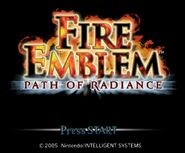
The main screen

A prerelease version of the logo.
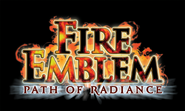
Logo of Path of Radiance
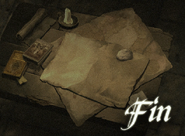
The ending screen.
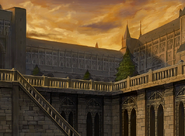
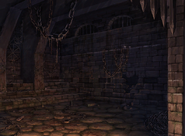

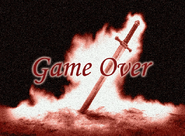
The Game Over screen.
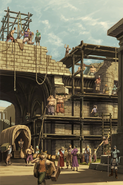
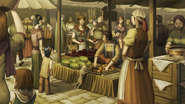
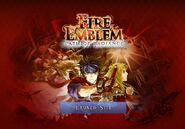
Path of Radiance website art
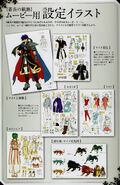
Concept art images of some of the main characters.
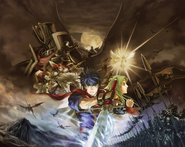
The full title screen image for Path of Radiance.
- ↑ https://tcrf.cyberspace/Fire_Emblem:_Path_of_Radiance#Internal_Project_Name
otwellgothered1950.blogspot.com
Source: https://fireemblem.fandom.com/wiki/Fire_Emblem:_Path_of_Radiance
0 Response to "Ike X Boyd Fire Emblem Path of Radiance Art"
Post a Comment